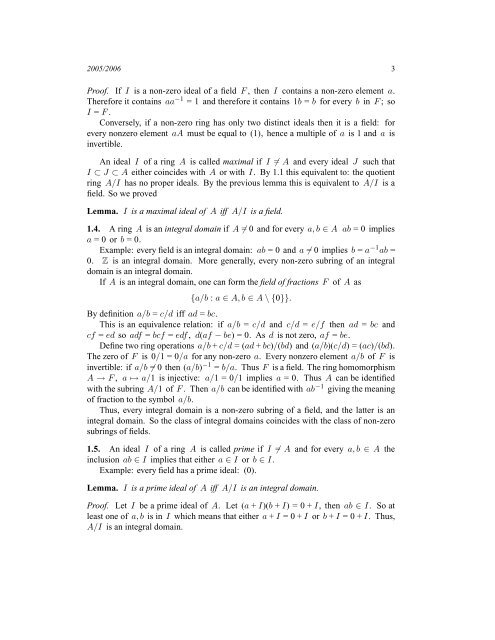Algebra (Unknown 27). - Index of
Algebra (Unknown 27). - Index of
Algebra (Unknown 27). - Index of
You also want an ePaper? Increase the reach of your titles
YUMPU automatically turns print PDFs into web optimized ePapers that Google loves.
2005/2006 3<br />
Pro<strong>of</strong>. If I is a non-zero ideal <strong>of</strong> a field F , then I contains a non-zero element a.<br />
Therefore it contains aa −1 = 1 and therefore it contains 1b = b for every b in F ; so<br />
I = F .<br />
Conversely, if a non-zero ring has only two distinct ideals then it is a field: for<br />
every nonzero element aA must be equal to (1), hence a multiple <strong>of</strong> a is 1 and a is<br />
invertible.<br />
An ideal I <strong>of</strong> a ring A is called maximal if I ≠ A and every ideal J such that<br />
I ⊂ J ⊂ A either coincides with A or with I. By 1.1 this equivalent to: the quotient<br />
ring A/I has no proper ideals. By the previous lemma this is equivalent to A/I is a<br />
field. So we proved<br />
Lemma. I is a maximal ideal <strong>of</strong> A iff A/I is a field.<br />
1.4. A ring A is an integral domain if A ≠ 0 and for every a, b ∈ A ab = 0 implies<br />
a = 0 or b = 0.<br />
Example: every field is an integral domain: ab = 0 and a ≠ 0 implies b = a −1 ab =<br />
0. Z is an integral domain. More generally, every non-zero subring <strong>of</strong> an integral<br />
domain is an integral domain.<br />
If A is an integral domain, one can form the field <strong>of</strong> fractions F <strong>of</strong> A as<br />
{a/b : a ∈ A, b ∈ A \ {0}}.<br />
By definition a/b = c/d iff ad = bc.<br />
This is an equivalence relation: if a/b = c/d and c/d = e/f then ad = bc and<br />
cf = ed so adf = bcf = edf , d(af − be) = 0. As d is not zero, af = be.<br />
Define two ring operations a/b + c/d = (ad + bc)/(bd) and (a/b)(c/d) = (ac)/(bd).<br />
The zero <strong>of</strong> F is 0/1 = 0/a for any non-zero a. Every nonzero element a/b <strong>of</strong> F is<br />
invertible: if a/b ≠ 0 then (a/b) −1 = b/a. Thus F is a field. The ring homomorphism<br />
A → F , a ↦→ a/1 is injective: a/1 = 0/1 implies a = 0. Thus A can be identified<br />
with the subring A/1 <strong>of</strong> F . Then a/b can be identified with ab −1 giving the meaning<br />
<strong>of</strong> fraction to the symbol a/b.<br />
Thus, every integral domain is a non-zero subring <strong>of</strong> a field, and the latter is an<br />
integral domain. So the class <strong>of</strong> integral domains coincides with the class <strong>of</strong> non-zero<br />
subrings <strong>of</strong> fields.<br />
1.5. An ideal I <strong>of</strong> a ring A is called prime if I ≠ A and for every a, b ∈ A the<br />
inclusion ab ∈ I implies that either a ∈ I or b ∈ I.<br />
Example: every field has a prime ideal: (0).<br />
Lemma. I is a prime ideal <strong>of</strong> A iff A/I is an integral domain.<br />
Pro<strong>of</strong>. Let I be a prime ideal <strong>of</strong> A. Let (a + I)(b + I) = 0 + I, then ab ∈ I. So at<br />
least one <strong>of</strong> a, b is in I which means that either a + I = 0 + I or b + I = 0 + I. Thus,<br />
A/I is an integral domain.

















